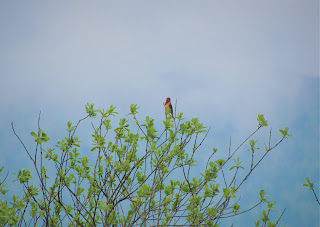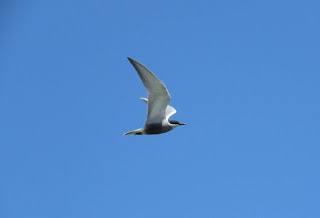Bogdej!
Deževna pomlad vztraja (več o njenih destruktivnih vplivih na Barje v prihodnje), jaz pa sem si privoščil sproščujoč predizpitni izlet na krasotno, bogato zalito Cerkniško polje. Nizkim temperaturam in gostim ploham navkljub sem sklenil otvoriti boso poletje, zato sem golih nožic in zavihanih hlač precopotal dobršen del jezerskega obrobja. Več ob slikah!
Abundantly wet meadows, photographed shortly after an abundantly wet storm.
Miserable Red-footed Falcons (Falco vespertinus) were forced to wait out the storm seated...
... but were shortly after the storm consoled by swarms of tasty Mayflies (Ephemoptera)
The constantly passing storms also interrupted a small flock of Bee-eaters (Merops apiaster).
The colourful birds took off immediately when the rain stopped.
These days, the valley is filled with the sounds of singing Reed Buntings (Emberiza schoeniculus)...
... common but beautiful Yellowhammers (Emberiza citrinella) ...
... Yellow Wagtails (Motacilla flava ssp. cinereocapilla) ...
... and of course with the song of the lake's most characteristic songbird, the Rosefinch (Carpodacus erythrinus) - groups of males are singing immensely.
I was lucky enough to have shared my bush shelter with a colourful male during the heaviest rain.
Another very characteristic breeder in the area is the Red-necked Grebe (Podiceps grisegena), that is in luck this year, as his typical habitat is abundant due to the incredible amount of water.
The rain forced the Golden Eagle (Aquila chrysaetos), breeder of the nearby Javorniki mountains, to descend from his kingdom high in the sky.
THE BLACK STORK SAGA:
A Black Stork (Ciconia nigra), sitting out the rain and plotting already...
She flies away in search of an honest bird from which to steal ...
Meanwhile, a younger stork performs an amazing hunt on the other side of the lake ...
... catching a formidable fish with its bear beak
Soon after its success, the stork mentioned before arrives and attempts to claim the fish for itself ...
... agitating the skilful hunter to the point, in which she drops the fish!
The plotting Stork snitches the enormous fish and shoves it down its throat. We can here observe the perfect example of life.
Formidable storms continued throughout the day...
... bothering interesting migrating birds and convincing them to stop and spend some time at the lakeside, just enough for me to observe and photograph them. In the picture we can see a resting Spoonbill (Palatela leucorodia) in the company of a lovely male Garganey (Anas querquedula).
The Spoonbill was better photographed in mid air, when it decided to move closer to a group of its heron friends, Little Egrets.
By doing so, it left behind another heron friend, the Purple Heron (Ardea purpurea)
Baby Swans taking a ride....
Displeased Barn Swallow
THE OTTER SAGA:
Sitting on a cliff, overlooking the full lake, i was disturbed by the sound of crackling reeds. I found the source of the sound and was most surprised - it was produced by an Otter (Lutra lutra), feasting with an enormous Common Rudd (Scardinus erythropthalmus).
After the completed feast, the Otter took some time to tidy itself, sprinkling water on its head, scratching and grooming its fur.
Full and cleaned, the Otter took a short walk, marked the reeds with some urine and departed, sliding elegantly in the lake. It was amazing to observe these uninterrupted few minutes of the predator's day.
Nekaj dni kasneje sem si privoščil še dva predizpitna oddiha; uspešen popis sicer nedokumentirane pisane penice (Sylvia nisoria) na Ljubljanskem barju ter docela neuspešen popis črnočelega srakoperja (Lanius minor) v Vipavski dolini.
The disguised Yellowhammer, the commonest bird, heard in Ljubljansko barje. During the Barred Warbler census, we recorded about 20 individuals (the two Barred Warblers were obv. not successfully photographed).
An unexpected sight for Barje at the end of may - a group of 5 Red-footed Falcons, sitting on a former Sunflower field in the pleasant morning.
An adorable finding - one of the two Tree Pipit (Anthus trivialis) nests we found during the census. The nest, positioned on a field, overgrown with invasive Goldenrod (Solidago sp), is a bowl-shaped hole in the ground, coated with dry grass and is almost impossible to spot.
A most elderly looking Butterfly from Vipava valley.
A wonderful plant Dianthus sanguineus, that can be found on extensive dry meadows ...
... alongside with enormous amounts of an orchid Serapias vomeracea
The bizar flower up close
Surprisingly, the last of Orchis morio can still be found blooming due to the cold may.
Another, more forest dependent orchid - Cephalantera damasonium
One of the most big and special slovenian orchids - Limnodorum abortivum (blooming specimen of the species, that was referred to in the last post as ''purple asparagus'') - is a special orchid, as it does not contain chloroplasts and does not perform photosynthesis. It depends instead on fungi, which provide it with all the nutrition it needs. It was also used in the past by young women, as it can be used to induce abortion.
Dictamnus albus - blooming in a rocky area, overlooking the upper parts of Vipava valley. This flower is special for its toxin, used in past by young men to avoid being recruited in the military. The toxin causes severe dermatitis when exposed to light.
A lovely Marsh Fritillary (Eurodryas aurinia)
LP, Matija































































